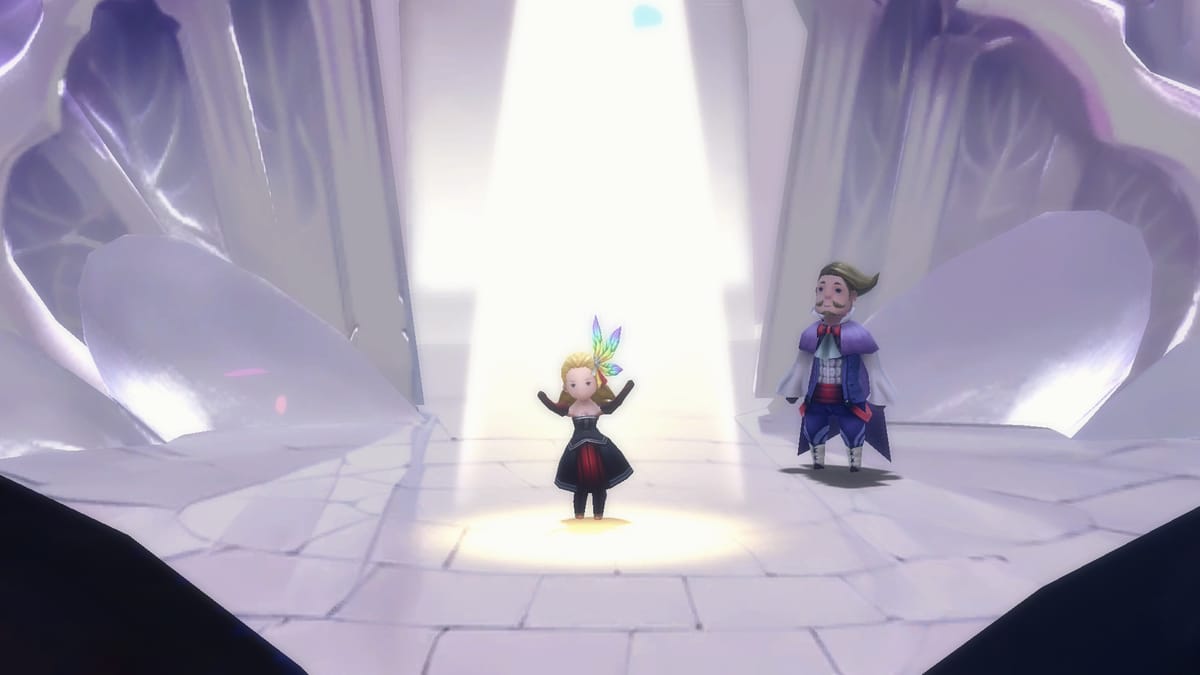
Bravely Default was one of SquareEnix’s many, many returns to turn-based gameplay for Final Fantasy. It may lack the FF name, but it’s got the spells, jobs, and complex plots of a Final Fantasy. Bravely Default and Bravely Second were fantastic turn-based RPGs on the 3DS, and now the first title has been remastered exclusively for Nintendo Switch. Bravely Default Flying Fairy HD Remaster translates what was a dual screen game into a single screen, while also enhancing the visuals, adding in quality of life features and minigames, and more. We’ve come at this game from two angles: that of a returning player and that of a newcomer.
David, the returning player
I adored Bravely Default and Bravely Second. Both have an incredible battle system, in which you can spend turns ahead of time or stock them up through the Brave and Default commands, which becomes even more strategic through a versatile job system. You can build the four main characters any way you want and swap between roles at a moment’s notice. The game, of course, responds in kind, with boss fights requiring you to either become overpowered or expertly exploit their weaknesses while guarding your own. It can feel a little grindy to get that wealth of options but, with a speed up feature and auto-battle, it never takes too long to get back to the main story.
That story is one of the best parts of Bravely Default and Bravely Second, with tons of fascinating twists and turns all the way through the final boss and beyond. The characters (except for Ringabel sometimes) are charming and delightful to watch on screen. I felt Bravely Default 2 didn’t live up to these original games in this regard and others, so coming back to the first title with this remaster has served as a nice reminder of why I fell in love with the series in the first place.
However, any connection the first game had to Bravely Second has been severed in this remaster (aside from the Ba’al Nemeses). The western release was actually an enhanced version of the Japanese version, which was subtitled “For the Sequel” in that region. This is still the For the Sequel version, with all of its enhancements and additional content included, just with all the Second connections cut out like the secret ending video. It’s disappointing, but understandable to a degree as a remaster of Second isn’t a guarantee (even though it should be).
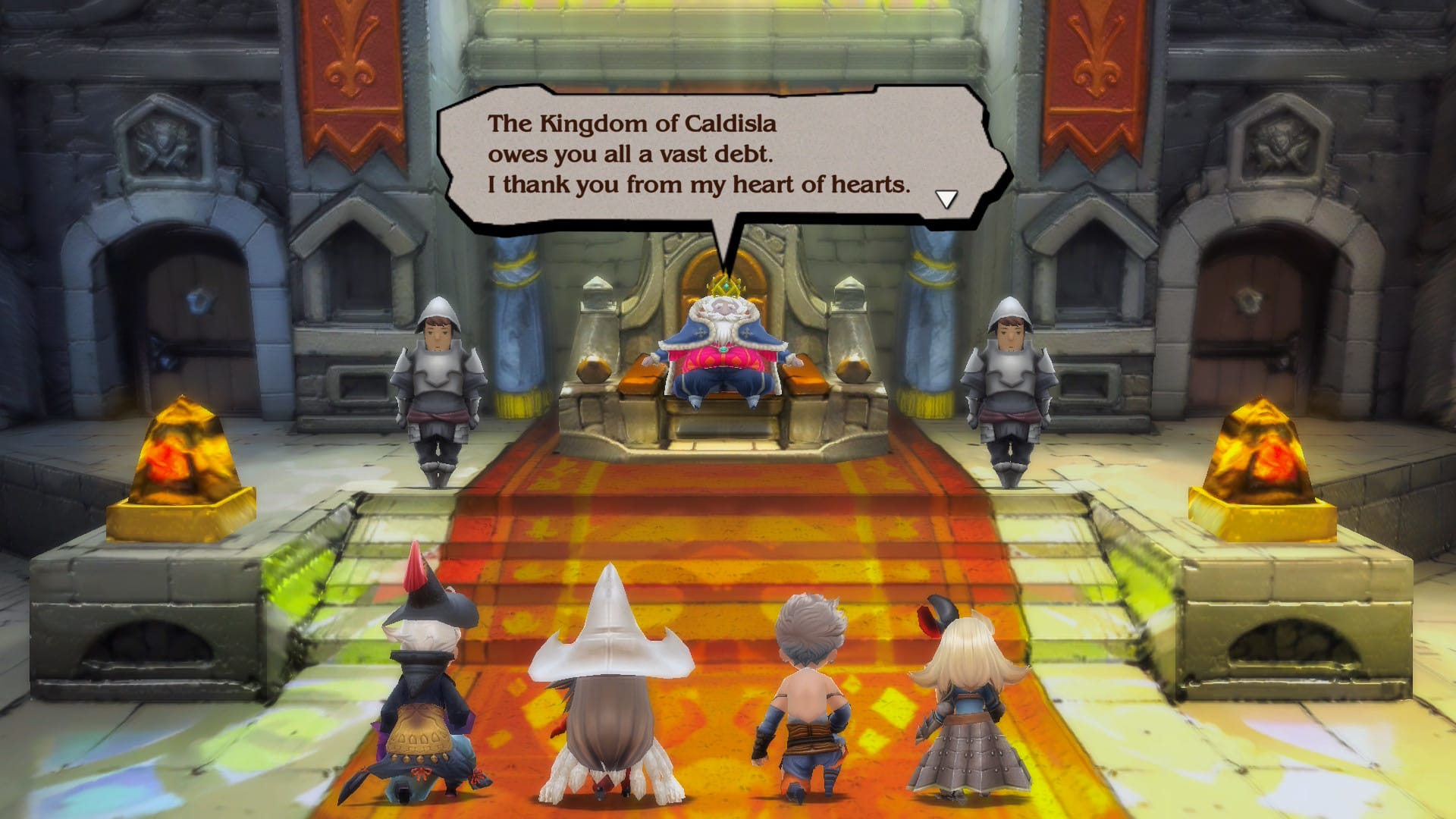
Instead, this remaster seeks to stand on its own. If it wanted to do that though, it really should have had a bit more effort put in. The opening cinematic with a slightly more realistic version of Agnès is neat to see in high resolution… but as a result you can see the seams on her body, specifically where her thighs fail to connect to her torso and leave a noticeable gap of nothing you can see through. It’s not a good first impression, but it’s a problem that persists with certain job outfits throughout the game. For example, when Tiz is wearing the Merchant outfit, at certain angles you can see that the inside of his coat isn’t textured all the way around, resulting in another gap. This would have been difficult or outright impossible to see on the 3DS’ 240p screen but on a 4K display or even the built-in 1080p screen it’s much easier to spot.
The visuals are certainly improved, just in a more general sense. In particular, the pre-rendered backgrounds are absolutely stunning here. They were lookers back on the 3DS, but seeing them here in their full glory is a treat. Character models and 3D environments have been cleaned up too, with higher resolution textures while still retaining the simple, adorable geometry that makes the art style so appealing. It’s less detailed than Bravely Default 2, with textures for mouths, but that’s also what makes it look so much better than that title. If the Bravely series continues, I do hope they’ll return to this more chibi look.

That said, not all the enhancements are for the better. In particular, the hair looks a bit too detailed. Using Tiz as an example again, there are more detail lines on his hair, but it just makes it feel a bit uncanny, like he’s wearing a wig from another dimension. Characters are affected by lighting a bit more as well, which works well in bright areas but in darker settings causes them to appear shiny and toy-like, making those unneeded details stand out all the more. In my eyes at least, the game is at its best when it’s mimicking the art of Akihiko Yoshida as closely as possible. You can even see his artwork now in the status menu for each character.
The game takes that HD moniker too far in some places, and not far enough in others. Shopkeepers and merchants are animated now when visiting their places of business, but you can really tell they haven’t received the same texture treatment as major characters. One thing at least that is purely an upgrade is the frame rate: Bravely Default Flying Fairy HD Remaster now runs at 60 fps as opposed to the original’s 30. It’s not like you need that reaction time in a turn-based RPG, for the most part, but it’s nice and smooth throughout.
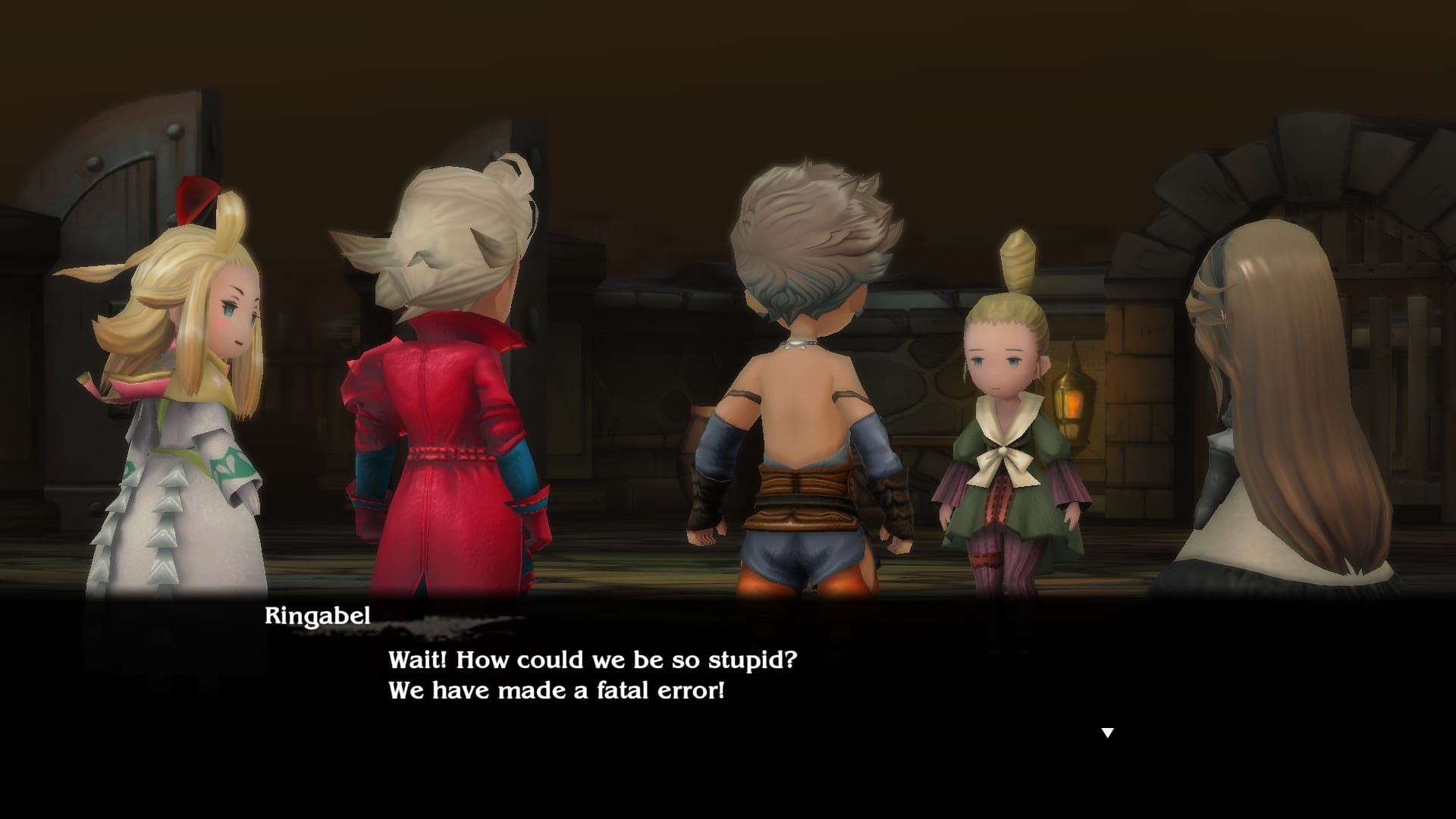
I say for the most part because you may actually benefit from that 60 fps in battle. Combat is turn-based, yes, but each character, upon meeting certain requirements determined by their equipped weapon, can use a special move. These Specials will replace the current battle theme with their own theme music, and any buffs conferred to the party will last until the song ends. Meaning to really take advantage of these specials you need to pick your moves fast, preferably triggering another character’s Special just before the current one ends to add more buffs to the stack and retain the current ones for even longer.
Since the game is now in one 16:9 screen as opposed to two screens of different shapes and sizes, it needs to fit the action and the menus together. It does this pretty simply: your party’s status is displayed at the bottom of the screen, the command menu shows up on the right with the currently acting party member moving to the left so it’s easier to tell whose turn it is, and enemy or party status can be viewed by pressing left or right on the D-pad respectively. Not being able to see enemy status at all times is really the only thing you lose here, but a quality of life feature has been backported from Bravely Second as you can now see an enemy’s HP after examining one of their types rather than having to examine every enemy individually.
Speaking of Bravely Second, the microtransaction mechanic of the same name is nowhere to be found here. Bravely Second allowed you to pause the battle at any time and interrupt whoever’s turn it was with your own, free* action. Now you’re strictly at the mercy of the turn-based flow, and while Bravely Second did save me a few times (with the passive point buildup, I’d never pay for that), the game is better for it being absent.
While it’s not real money, you do have to pay for certain features now using the new currency gained from the Mouse Mode minigames. You can change the encounter rate at any time using a menu that’s always reminding you it’s there with a bulbous prompt on the left side of the screen (seriously, let me hide that it’s ugly). This menu is also where you’ll find D’s Journal, an archive of past and future events, Norende Village, a town you can rebuild for extra items and equipment, auto-battle management, and a shortcut to the minigames once unlocked. The original game let you set the encounter rate to 0% from the get go, which was convenient and allowed for some cool low-level runs, with players only fighting bosses. You can still do level 1 runs by turning off experience gain in the menu, but 0% encounter rate is now locked behind the minigames, which are only accessible upon reaching Chapter 2.

It’s incredibly weird to hide this feature, in particular behind minigames, as it’s something that the game received a lot of praise for when it initially released. There’s a lot of stuff you can purchase using the mingame currency too, including a limit break attachment for specials, costumes for each character (yes, you do have to buy the permanent job clothes costume four times if you want to keep the default outfits), weapons, armor, and a 400% encounter rate. These items can cost a lot, and there doesn’t seem to be another way to earn it other than minigames, so to the Mouse Mode mines we go.
There are two minigames here: Luxencheer Rhythm Catch, a rhythm minigame with a total of five songs to unlock, and Ringabel’s Panic Cruise, which has 3 total stages. Luxencheer Rhythm Catch has you using both a left and right mouse cursor as glow sticks, hitting notes that appear using the line that forms between the two, bringing them together, or clicking on other prompts. It’s fun enough for what it is, and lets you listen to some of the fantastic music by REVO.

Ringabel’s Panic Cruise is a bit more complicated, having you steer an airship through a set of rings while fulfilling the requests of other party members. Your two cursors serve as your two hands here, so you can grip the ship’s wheel with your right and adjust the altitude with your left. Characters will chime in with other requests, like changing the music, temperature, or some switches, swatting flies, and repairing the ship literally on the fly. I did find this one more enjoyable, but it’s still not particularly engaging. Any one run of a minigame will never give you enough tokens to afford anything cool, so you’ll have to play each stage and difficulty multiple times to get what you want.
Bravely Default is a game that greatly rewards patience and perseverance. It can be very difficult, grindy, and the second half can be incredibly tedious. However, seeing it through to the end, as the game begs after pressing New Game, is well worth all the hardships along the way. This is a phenomenal game, but the HD Remaster part feels like it needed a bit more time in the oven visually, even if the quality of life improvements make the game a lot easier to play.

Jack, the newcomer
Perspective plays a big role in how enjoyable Bravely Default can be. Although this release marks the first time I’ve played Bravely Default, I often felt like I played this game before. That’s not a bad thing: Bravely Default borrows from beloved RPGs from the past (particularly MY beloved RPGs) while giving those ideas some fresh spins and a healthy dose of meta introspection. However, it did all that over a decade ago, and it’s now well on its way to being as retro as the games that inspired it. In many ways, Bravely Default aging feels wrong – it’s a game that perpetually aims to be “modern.” Yet the flow of time stops for no one, and what one gets out of Bravely Default HD in the modern day will depend entirely on their own experiences.
At its core, Bravely Default contains everything that I enjoy about RPGs. It’s simple and straightforward on the surface, with plenty of depth lurking just underneath it. The cutesy art style reminds me of early Playstation RPGs and the production values sit comfortably in that era – efficient, precise, and to the point. While that works just fine for me, the more universally appealing aspect of the game is its battle system. You can freely customize your party members with different jobs, abilities, and equipment to create a variety of personalized teams; whether it’s FFV or Metaphor, systems like this always draw me in.
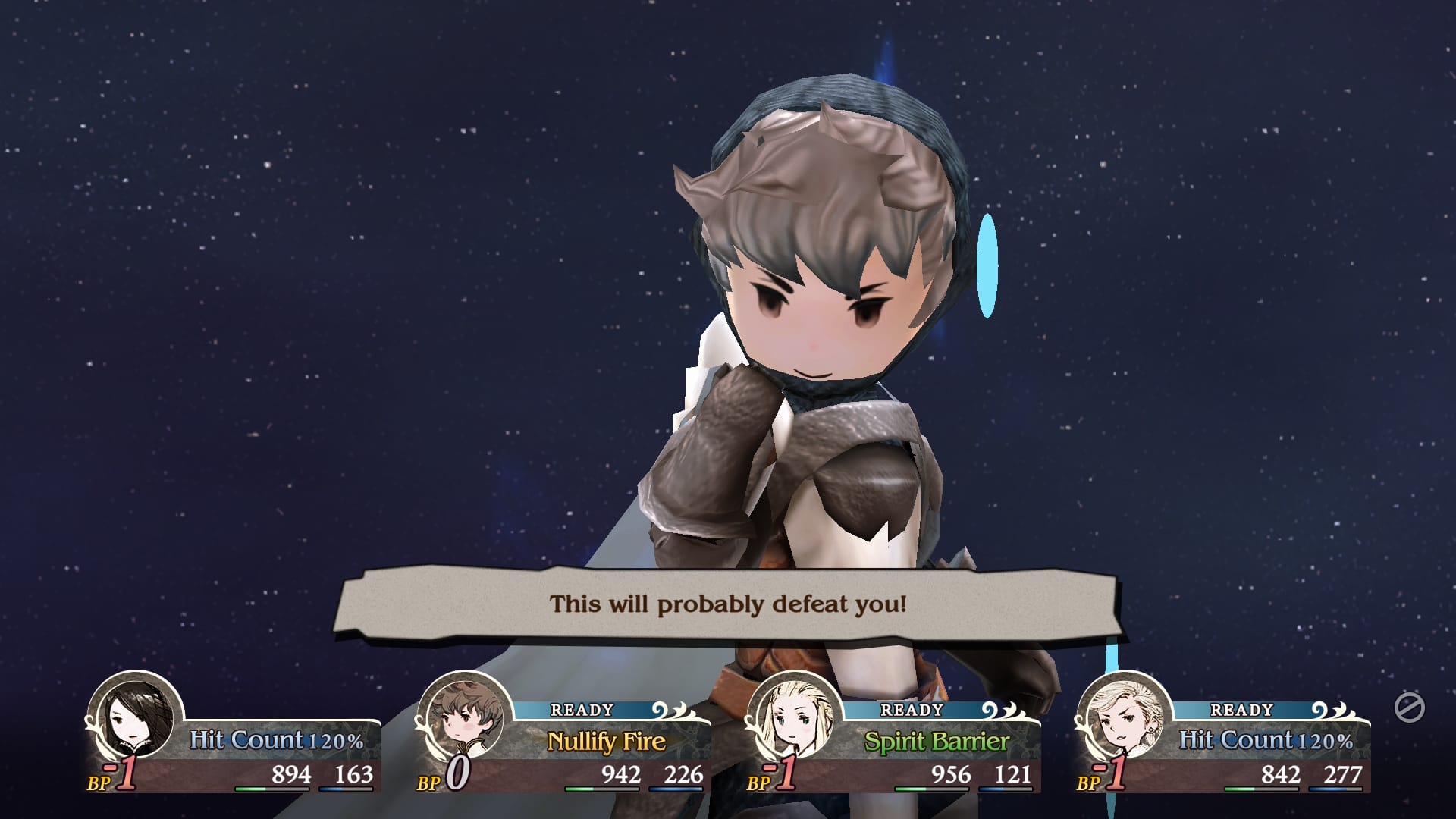
Everything I mentioned about Bravely Default in the preceding paragraph shares one trait: I like them because they’re like other games I like. Bravely Default both celebrates and weaponizes the familiar, which is I suppose what separates it from its inspiration. Through no fault of Bravely Default, we’ve basically been spending the past decade of things being meta, up to and including reality. Its modern twists, both narrative and mechanical, were dulled considerably for me.
Mechanically, Bravely Default’s big innovations are its “Brave” and “Default” systems, which create a sort-of “turn economy” system. You can save turns or use a bunch in one go with the consequence that you go into turn debt, file turn bankruptcy, commit turn tax fraud, and get thrown into turn jail while the enemies beat you up.
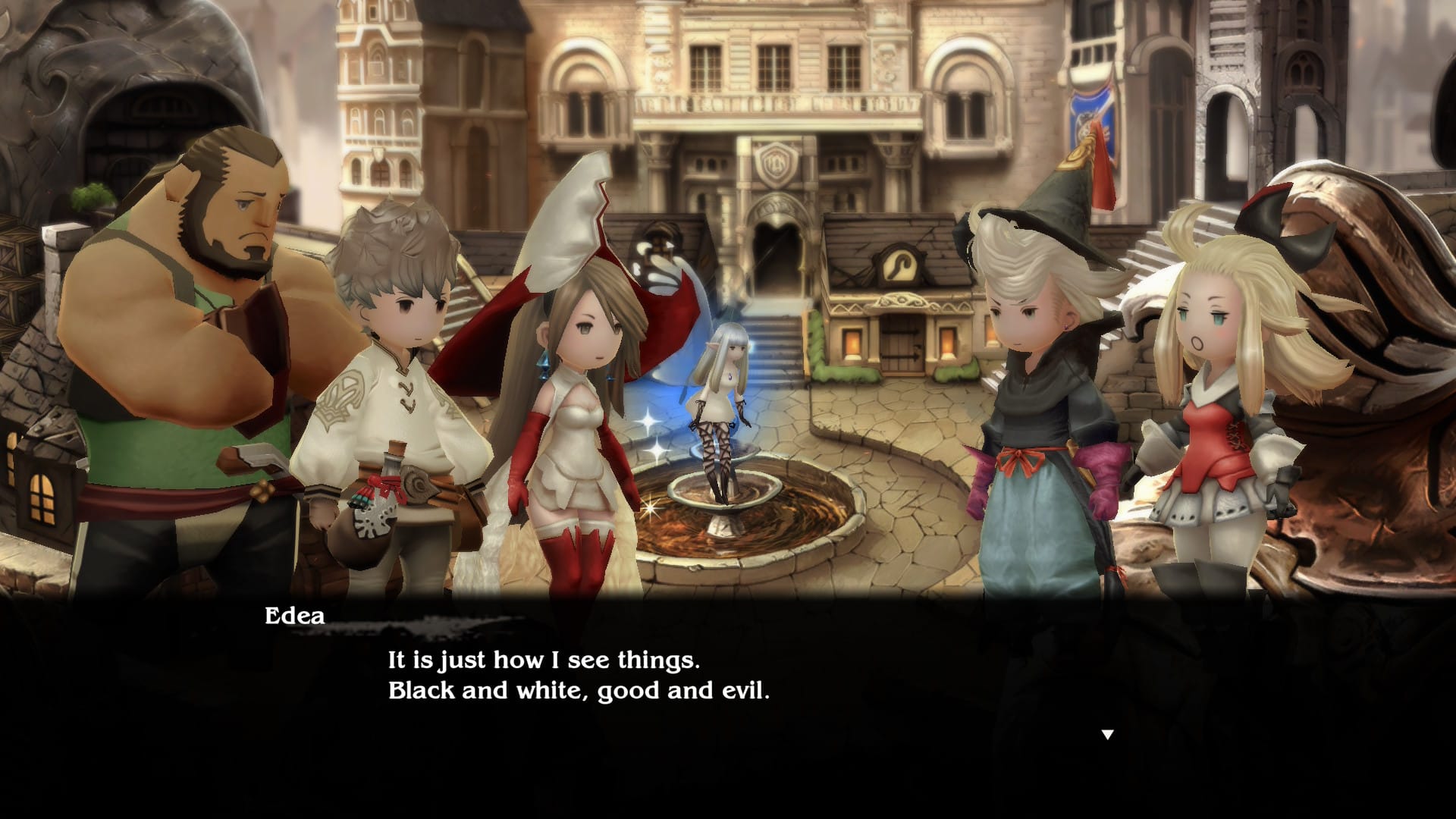
While these concepts are interesting, they didn’t feel quite as game changing as I was expecting when the game first introduced them to me. It can be difficult or simply unrewarding to actively try to think about who should be saving turns or who should be cashing out on them on a turn-by-turn basis. Such considerations often (bravely) default to when it makes sense to be attacking or defending with each character – the buffers and healers obviously should stay nimble with turns while the attackers can afford to go all out (especially if you know the enemy is almost dead).
Instead of its battle mechanics, Bravely Default’s true place in history seems to be appropriately meta. This was the first game I can remember that really pushed convenience features onto the player that we are now corporate-mandated to call “accessibility” features. You can nerf enemy encounter rates, speed up gameplay, and even completely automate your characters so that the game plays itself. You can even summon cheats from other players to win battles for you with some slightly dodgy online implementation. While this was the first time I experienced them firsthand in Bravely, features like this are found in many modern releases, particularly of classic games now.
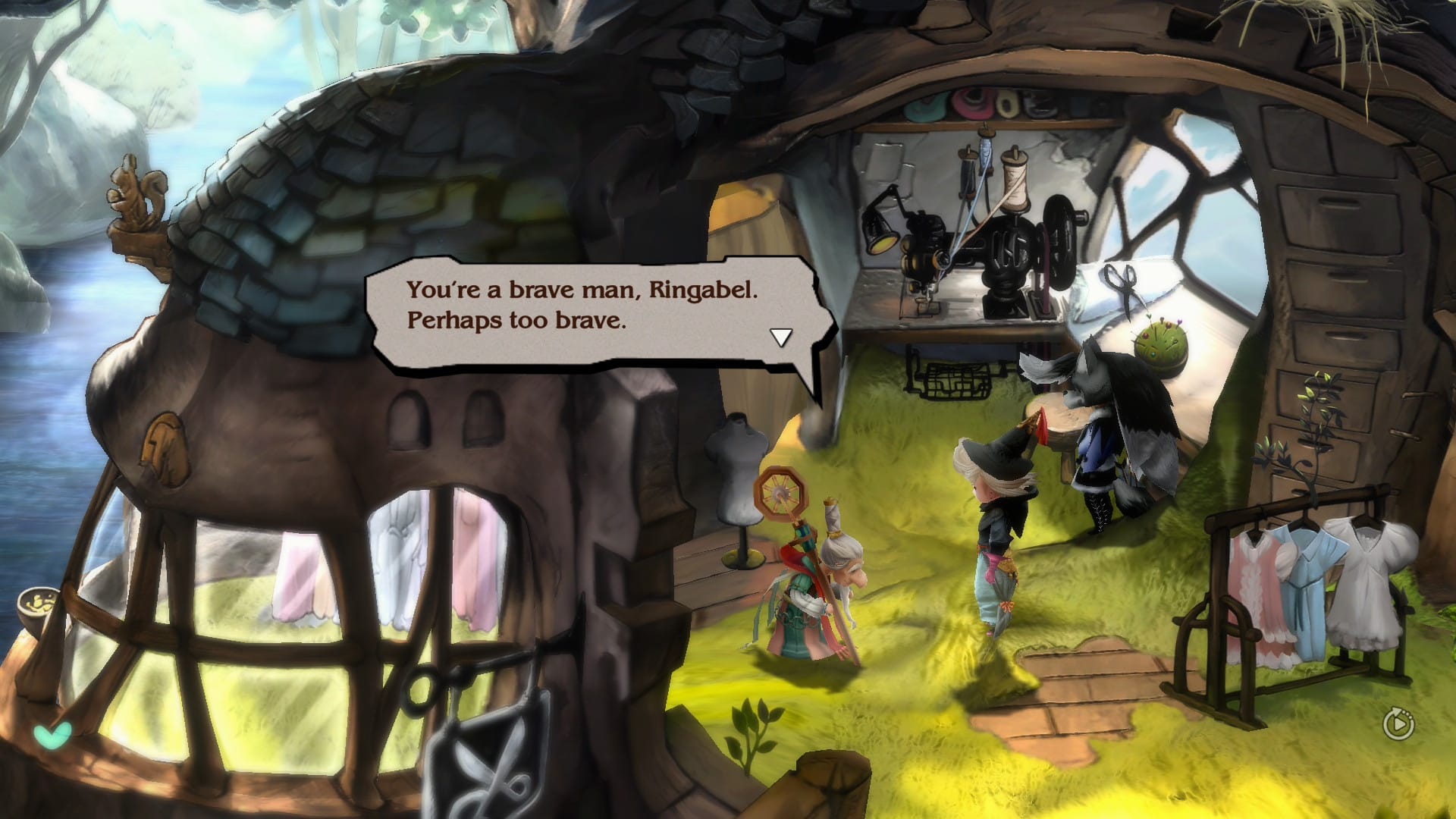
Are these features convenient? Undoubtedly. Are they good? I think that’s a more difficult question to answer. These options beg existential questions about game design. What’s the point of making elaborate battle animations if you encourage people to zoom past them? How do you balance difficulty progression and dungeon difficulty for an RPG when you can turn off the difficulty at any time? If Bravely Default is anything to go by, it’s that there isn’t much point and you don’t really respectively.
To its credit, Bravely Default puts up a good fight and you do need to craft strong teams (and maybe save up some special attacks) to effectively defeat boss encounters. However, I found that, even with the encounters set to maximum, it took a good amount of fights to build my teams up where I needed (or at least wanted) them to be. Grinding may not strictly be essential, but it kinda felt like it was – perfect for the convenience features Bravely Default designs itself around. In that sense, it almost comes across like the game was designed backwards for its convenience features, which further gets emphasized with some late game choices.

Despite its unevenness, I had a good time with Bravely Default. The job system combinations are fun to mess around with and at least do inherently lend themselves to grinding simply to see what monstrosities you can create. Beyond that, the characters are fun and I especially like how much detail and opportunity the game allows for them to breathe. The journal that updates throughout the game as well as the optional conversations between party members are great touches.
Bravely Default HD encapsulates my Switch 2 experience in general. Bravely Default HD was fresh for me, but likely not for anyone who has played it before. Similarly, Switch 2 may be fresh for those who stuck to just Nintendo the past 8 years, but somewhat underwhelming for those with other consoles, PCs, or competitor handheld devices. I enjoyed the game and I liked the characters, but I’m not sure if this is the kind of game I’d play again. I suppose that means that I may have not chosen to play this game at all had I played it on the 3DS. From that perspective, I’d say I enjoyed Bravely Default now but was somewhat underwhelmed with Bravely Default HD in the future. How meta.
Bravely Default Flying Fairy HD Remaster
Great
Bravely Default Flying Fairy is a great game, and while this HD Remaster cleans things up a bit its efforts often feel lacking. It looks better in some ways, but the same in others and plays better in some ways but worse in others. If you enjoy experimenting with character builds, it’s a great time, but it’s still going to take some grinding to get there. If you can persist through the grind, you’ll find the same diamond in the rough that the game was on the 3DS.
Pros
- Stunning backgrounds
- Fantastic battle and job systems
- Reworked online features
Cons
- Some upscaled textures clash with the art style
- A few features are behind minigames now for no reason
- Very grindy
This review is based on a retail Nintendo Switch 2 copy provided by the publisher.

